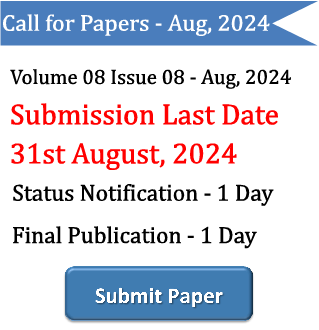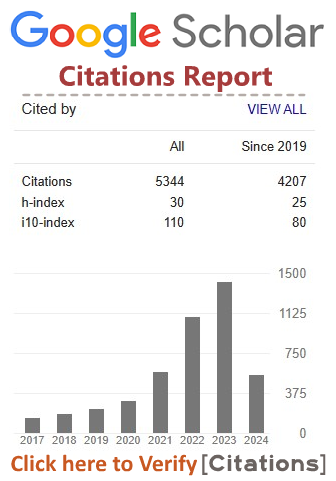Guildelines
A well-defined research issue should be the starting point of any scientific analysis, which should conclude with a useful analysis methodology that lays out the overall strategy. This basis should provide a body of information from which the document may be derived.
Submissions of manuscripts to journals for consideration for publication often contain the following components. Consequently, rather than serving to further obfuscate the ideas and findings, the text itself should serve to enhance the effort of communicating the scientific evidence.
Title Page:
There should be a title page. Mention the authors and their affiliations with the manuscript’s title, which should be brief and straightforward. Declare which journal you are submitting the work to. List around five essential terms together with a brief title (sometimes known as a running title) for the work. Lastly, include the related author’s full contact information.
Abstract:
Usually, the abstract is one paragraph long.The abstract should be viewed as a freelancing document for an associate’s degree in nursing, meaning that no information in the abstract depends on any information in the report’s body, and vice versa.The experiment’s goal should be stated explicitly in the opening phrase.If a hypothesis is used to guide the experiment—which is highly recommended—it should be clearly expressed and accompanied by statements outlining its foundation and assessment.The phrases that follow explain how the inquiry was conducted.The outcomes of the experiment are described in the following phrases as precisely as possible without being lengthy. The concluding phrases highlight the significance of the findings and, consequently, how this effort will affect the ultimate subject of research.
Introduction:
A succinct summary of the literature addressing the analysis issue is necessary for the introduction. The ideal way to structure the introduction is like a descriptive funnel: start with a wide range of subjects and gradually narrow it down to the job at hand. It could take three or four paragraphs. Another strategy is to begin by introducing the reader to the ultimate subject of study in one or two paragraphs. Then, a section of this field can be improved, as explained in the following paragraphs. The last paragraph is really important. It is very evident what experimental question the current investigation is trying to solve, probably in the first phrase of the paragraph. Next, the hypothesis is made clear. Next, briefly outline the strategy used to verify the hypothesis.Lastly, an overview phrase adds further information by indicating how the answer to your query might advance the subject of research as a whole.
Methods:
This section should be a straightforward description of the methods used in your study. Each technique ought to be delineated during a separate section. Begin, in a single section, with a statement of the materials used in the study, indicating the vendor and vendor contact information for each material. This data is crucial in order that readers have the aptitude to repeat the add their own establishments. NeXT describe, in separate sections, each key procedure and technique used in the study. Keep explanations brief and concise. If a selected experimental style is employed, describe this style within the second section of the ways, after the materials section. Similarly, if a theoretical or modeling element is employed, it ought to even be incorporated within the initial portion of the ways.
Finally, remember to describe the statistical analysis methods that were utilized to analyze the results, most likely in the final section of the Methods section. Although it is typically not recommended, the use of the passive voice is probably appropriate in the Methods section.
Results:
The Results section presents the experimental information to the reader and is not a place for discussion or interpretation of the data. The data itself ought to be given in tables and figures (see below).
Introduce every cluster of tables and figures during a separate paragraph wherever the general trends and information points of explicit interest square measure noted. You may need to point the position of a selected table or figure within the text.
For experimental studies, key statistics such as the number of samples (n), the index of dispersion (SD, SEM), and the index of central tendency (mean, median or mode) must be stated. Include any applied math analysis that was performed, and make sure to indicate specific statistical data, such as p-values.
Note that every table and figure within the paper should be said within the Results section.
Discussion:
The discussion section, often the most difficult to write, should be relatively easy if the previous suggestions have been followed. In explicit, look to the last paragraph of the introduction. If the work has characterized a development by finding out specific effects, use the results to describe each effect in separate paragraphs.
If the work has presented a hypothesis, use the results to construct a logical argument that supports or rejects your hypothesis. If the work has identified three main objectives for the work, use the results to address each of these objectives. A well-defined study that is described in the Introduction, along with supporting results that are presented in the Results section, should ease the construction of the Discussion section. Begin the Discussion section with a short paragraph that once more provides an outline to the work.
Summarize the most important findings and, if applicable, accept or reject the proposed hypothesis. Next, identify the most interesting, significant, remarkable findings that were presented in the Results section, and contrast these findings in light of other studies reported in the literature. It is usually informative if a discussion of the potential weaknesses of the interpretation is additionally enclosed.
Finally, at the end of the Discussion section, consider the other works in the literature that address this topic and how this work contributes to the overall field of study.
Conclusions:
Again, initial introduce the work and so in brief state the main results. Then state the major points of the discussion. Finally, finish with a press release of however this work contributes to the general field of study.
Submit you Papers at :- editors@acgjournal.org

A DOI will help Author(s) easily locate a document from your citation. Think of it like a Social Security number for the article you’re citing — it will always refer to that article, and only that one. While a web address (URL) might change, the DOI will never change.
Where can i find DOI:
- In ACGCRJ journal articles, the DOI will be printed with the article itself, usually on the Hader of the page
- If the DOI isn’t included in the article, look it up on the website org(use the “Search Metadata” option) to check for an assigned DOI.
Benefits:
- Allows for a quick and precise search.
- Article can always be located.
- Persistent link to its location on the Internet.
- Easier identification of published articles even if the metadata URL is changed.
- Aid in citation tracking, ensuring a researcher has accurate metrics on how and where their research outputs are being used or referenced.
What type of papers does ACG CASE RESEARCH JOURNAL (ACGCRJ) publish?
Research Paper, Survey Paper, Informative Article, Case Studies, Review Papers, Comparative Studies
How long does it take for an accepted paper to be actually published?
Approximate will inform within 24 hours via email and sms.
What is the procedure to submit my paper?
Please Submit your Research Paper here Submit Research Paper Online – ACGCRJ
What is a Paper ID?
Paper ID is an Unique Identification Code provided to your submitted Manuscript. You should always mention the Paper ID during any communication with us.
How long my published paper will stay online?
Lifetime.
May I submit more than one article?
We will accept multiple submissions across multiple communities, as long as the author joins each community.
Indian Authors
The journal requires authors to cover a minimal processing fee for paper publication. This fee primarily supports office operational costs, website maintenance, and compensates paper reviewers and editorial board members for their services to the journal. There are two publication cost options: papers with a DOI require a fee of INR 1500, while those without DOI incur a lower cost of INR 1300.
Foreign Authors
Foreign authors are required to pay a processing fee for publishing their papers in our journal. Similar to domestic authors, this fee is allocated towards office operational costs, website maintenance, and compensating paper reviewers and editorial board members for their contributions to the journal. The publication costs for foreign authors may also vary: papers with a DOI will have a fee of $ 40/- USD, while those without DOI will incur a reduced cost of $ 30/- USD
ACGCRJ is one of the world’s leading and fastest-growing research publications with the paramount objective of discovering advances by publishing insightful, double-blind, peer-reviewed scientific journals.
The Submitted Article/Paper will accept within 12-24 Hours, and it can publish within 24 Hours
Manuscript Submission – Check Manuscript Plagiarism – Send for Editorial Review – Final Decision to Author – Payment of Publication Fee – Re-screening – Final Publication
For Management, Hosting & Office Expenditure ACGCRJ Journal may charge some amount to publish the paper.
To Publish a Paper ₹: 1300/- INR (without DOI)
₹:1500/- INR (with DOI)

As much as feasible under all copyright and associated or adjacent rights have been relinquished by Indospace Publications to Journal. India is where this work is published



